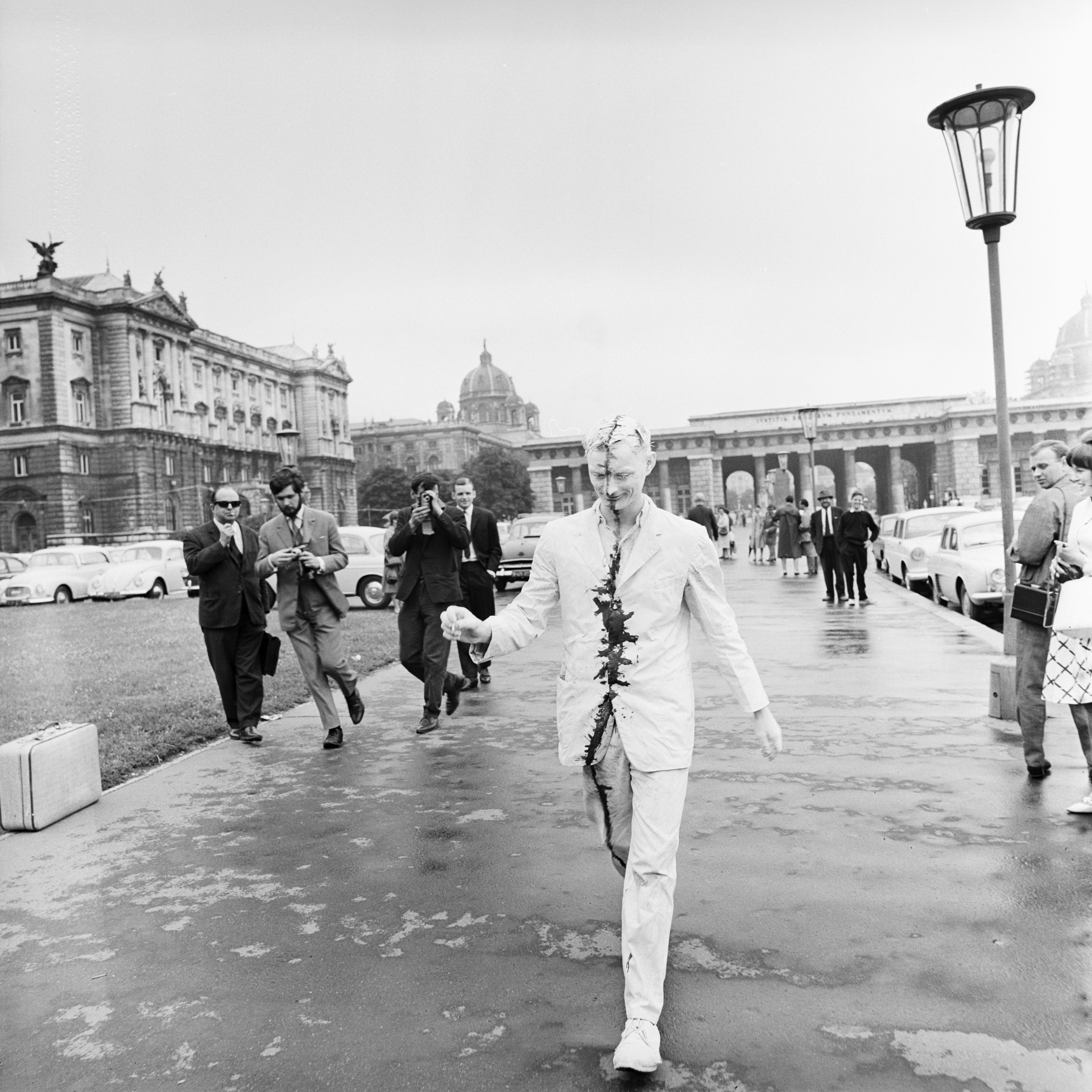
Vienna Actionism
©
© ©Günter Brus, Photo: mumok - Museum moderner Kunst Stiftung Ludwig Wien
Vienna Actionism
Viennese Actionism
The 1960s were marked by a radical artistic upheaval. Artists sought immediate, sensory experience and deliberately transgressed the boundaries of traditional art forms. Against this backdrop, Actionism emerged in Vienna as a radical movement. Its central figures—Günter Brus, Otto Muehl, Hermann Nitsch, and Rudolf Schwarzkogler—developed new artistic forms of expression through actions and manifestos, aiming to fundamentally challenge established notions of art and physicality.
As an international research center for Vienna Actionism, mumok not only houses significant works by Viennese Actionists Günter Brus, Otto Muehl, Hermann Nitsch, and Rudolf Schwarzkogler, but also holds extensive historical documentation, including numerous records, notebooks, action photographs, sketches, and correspondence. The collection traces the development of Actionism from its early engagement with painting to the transgression of the traditional panel painting in favor of staging events in space and time. In its scope, the collection is unique worldwide.
Otto Muehl
Otto Mühl (1925–2013), the oldest of the four main representatives of Viennese Actionism, was conscripted into the Wehrmacht at the age of 18 during World War II. After the war, he studied German and history to become a teacher, as well as an art educator. At the same time, he began to pursue his own artistic practice. As early as the beginning of the 1960s, Mühl, who used the spelling Muehl in his artistic work, developed what he called “material actions,” building on the transgression of the panel painting.
In 1970, he founded a community that, although it referred to itself as a commune, was in fact organized in a sect-like manner. Originally established as the “Action-Analytical Organization (AAO),” the sect soon spread from its central base at Friedrichshof in Burgenland to several other European countries. It was characterized by a rigid hierarchy, ideological control, and the systematic dissolution of family structures. Legal proceedings initiated in the late 1980s ultimately uncovered serious abuses, leading to Mühl’s conviction in 1991, particularly for the sexual abuse of minors and drug-related offenses. Against this background, the objects created since 1970 in particular demand a critical reassessment and contextualized reception today.
mumok has been strategically collecting works of Viennese Actionism since the mid-1980s, including numerous objects by Otto Muehl. A current project by the Collections and Education Department, funded by the Ministry for Housing, Arts, Culture, Media and Sport Republic of Austria (BMWKMS), is currently working on the comprehensive cataloging, digitization, and contextualization of the Viennese Actionism archive, which includes thousands of documents, photographs, films, and letters by the movement’s key figures. The results will be made available both on mumok’s online platforms and in a dedicated research publication.
mumok sees itself as a center of expertise for the critical engagement with Viennese Actionism. Transparency and multiperspectivity are central to this approach. Through the focus of the current research project, the active involvement of external experts, and an open scholarly dialogue, mumok makes a significant contribution to preserving Austria’s cultural heritage while also promoting its critical contextualization and international academic exchange. This approach opens up new interpretive possibilities for one of the most influential—yet also most controversial—artistic movements of the 20th century, ensuring its thoughtful presentation and accessibility for future generations.
In the spirit of open and critical collection research, it is essential for mumok to continually examine and reassess its holdings in light of new sources, contexts, and historical documents.
academic inquiries
We are always available for scientific and research inquiries.
Go to the online collection
© mumok – museum moderner kunst stiftung ludwig wien
![[Translate to English:] Hermann Nitsch, 16. Aktion, für Stan Brakhage, 1965](/fileadmin/_processed_/4/0/csm_MG_400_1_Nitsch_42_Web_6dc3272ba1.jpg)
![[Translate to English:] Otto Muehl, Materialaktion Nr. 26, Nahrungsmitteltest, Februar/März 1966](/fileadmin/_processed_/1/e/csm_00034374_m_b0804bd9ce.jpg)
![[Translate to English:] Rudolf Schwarzkogler, 3. Aktion, Sommer 1965, 1965](/fileadmin/_processed_/2/4/csm_OEl-Stg_178_3_Schwarzkogler60_he_Web_580a83e6f6.jpg)
![[Translate to English:] Günter Brus, Wiener Spaziergang, 1965 (1989)](/fileadmin/_processed_/3/b/csm_MG_159_0_Brus1_02_Web_7dc24afc6c.jpg)
![[Translate to English:] Rudolf Schwarzkogler, Ohne Titel (Sigmund-Freud-Bild), 1965](/fileadmin/_processed_/f/9/csm_OEL-Stg_165_0_Schwarzkogler1_he_Web_5a5054a189.jpg)
![[Translate to English:] Günter Brus, Ohne Titel, 1960](/fileadmin/_processed_/8/c/csm_G_1010_0_Brus3_dig_Web_f7f6da2364.jpg)
![[Translate to English:] Hermann Nitsch, Die Wunden des Ölbergs bluten, 1960](/fileadmin/_processed_/e/3/csm_B_463_0_Nitsch_scan-neu_Web_4a4d068d91.jpg)